Exactly one year ago, eight governors across the US took the initial move to close bars and restaurants, and the Dow Jones posted its largest one-day drop ever, finishing down a record 2,997 points. The world as we knew it was hitting the proverbial fan. New incoming information —none of which was encouraging — came across our screens at a frantic pace, causing our stomachs and portfolios to drop in tandem.
With a full year now passed by in the COVID economy, the universe of uncertainty has thankfully compressed. While it was not an advanced degree that any of us had applied for, the pandemic has imparted a lifetime of lessons, offering clear clues about the future of commercial space demand and the ways we as humans interact with the built environment.
Macroeconomy
Starting first with the economy as a whole, I know we have all become a bit numb to sideways numbers during the past year, but to dig ourselves out of this hole, it is important to understand just how deep we are. Early last year, while we were all still finishing our champagne and settling in after the holiday season, the Congressional Budget Office released its estimates of 2020 economic growth, serving as a reliable benchmark of where the economy would have stood without the pandemic. Actual output last year fell short of the CBO’s early 2020 forecast by $1.2 Trillion Dollars, good for an average loss of $3,560.06 for every American.
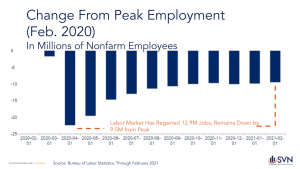
More workers filed for initial unemployment claims in the first nine weeks of this crisis than during the entirety of the 2007-2009 recession, and the unemployment rate hit a stratospheric high of 14.8% last April. Through the most recent Jobs report, it looks like we are once again starting to see some positive momentum toward an eventual recovery. The civilian unemployment rate ticked down 6.2% through February as the economy added back 379,000 jobs. We remain a long way to go, but between vaccination rollout and the onset of warmer weather, the W-shaped recession we have seen so far should have enough fuel in the tank to prevent another near-term downturn.
Multifamily
An often-peddled refrain during the early days of the pandemic was that the multifamily, and apartment sector as a whole, would maintain its stability by the simple fact that people will always need somewhere to live. If anything, the same optimists argued that the resiliency of cashflows could actually improve as renters were spending more time in their homes due to involuntary quarantines. With a year of data available now supplanting conjecture, we find that residential rentals have indeed performed up to expectations. No, conditions have not been ideal, and distress is not too hard to find, especially in gateway markets. However, compared to worst-case scenarios, the apartment sector has lived up to its reliable bedrock status. According to the National Multifamily Housing Council’s rent tracker, which follows the performance of more than 11 million professionally managed apartments, 93.5% of renter households paid rent in February— only a 1.6% drop off from the same month last year. These data may, however, likely understate some sector-level underperformance, as they do not include vacant units or self-managed “mom-and-pop” properties. According to Freddie Mac’s latest forbearance report, we know that small balance originations, which tend to cater to the “mom-and-pop” investor class, make up 75% of loans in forbearance.1
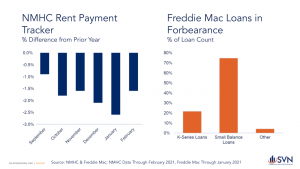
The CDC’s eviction moratorium remains a pressing challenge for the industry and an impediment to its return to pre-pandemic health. The market for rental housing is a circular flowing ecosystem between lenders, investors, and renters. There is no net-positive corrective policy that achieves more benefit than harm by breaking the symbiotic process, much as the moratoriums have. The NMHC offers that moratoriums “fail in their purpose of addressing renters’ underlying financial distress” and “jeopardize the stability of housing providers and the broader housing market.” Despite two different federal judges ruling against the CDC policy in the past month, the ban remains in place. There are, however, green shoots forming, which could signal a return to more normal conditions in the near future. At the end of this month, the moratorium is scheduled to expire— a deadline that we should accept with a coarse-grained piece of salt. Nevertheless, the appropriations bill passed at the end of the year, and the American Rescue Plan of 2021 passed last week collectively set aside $46.6B for rental assistance programs. A CPPB analysis of Census Bureau survey data finds that roughly one-in-five renter households are behind on rent— a crisis that should see meaningful relief as funds are released.2
The permanence of COVID-induced migration will be a hot-button topic as more jabs land in arms. Taken together, the trifecta of New York, California, and Illinois, the states that are home to the three largest US cities, collectively lost more than 275,000 residents in 2020. The human density that has historically attracted demand toward superstar cities has had the complete opposite effect in the past year. Without accessible cultural amenities or the need to be in an office Monday through Friday, a significant share of the workforce became untethered to their home cities and have made their way toward the exit. According to CoStar, New York, LA, San Francisco, Chicago, Seattle, Boston, and Washington DC are all among the list of cities to post year-over-year declines in asking rents through Q4 2020.
While the outgoing flow of residents has been lumped together as one homogenous cohort, there appear to be at least two major groups leaving. The first group of COVID-nomads is defined by those that already had eyes towards more affordable and spacious housing options over the next couple of years. Given the urban context in 2020 and the attractively low borrowing costs, many of these renters simply said, “Hey, why not now?” and moved up their progression timeline. These are the types of households that are more likely to be buying baby carriages before the next time they step on a subway, and their transition out of major metros is probabilistically permanent. The second group contains those who are transient, often early into their careers, working remotely, and still seeking the lifestyle amenities they had enjoyed pre-covid. Watching how this group behaves as large companies start calling workers back into the Office and cities look more like their pre-pandemic selves will be telling.
Office
Today, there is no property type subject to more speculation than the Office.


Unlike multifamily, Retail, and industrial, where COVID has mostly magnified pre-existing trends, the pandemic has led to rampant reimagination in the office sector. Our understanding of how both firms and workers interact with physical office space to optimize productivity is permanently changed. According to the Census Bureau’s Household Pulse Survey, an estimated 38% of working American adults have transitioned to remote work in some capacity due to COVID. The share is even higher in large office markets like New York and Los Angeles, rising to 47% and 45%, respectively. En Masse, The American Workforce traded morning commutes for Zoom links, an illuminating natural experiment that has challenged the Office sector’s core-assumptions. When PwC launched its remote work survey in June, 44% of employers thought that the transition to remote work has allowed their teams to be more productive than before the pandemic.3 When the same employers were polled again in December, the share climbed to 52%, indicating that not only has a consensus emerged, but that efficiency has improved following the initial learning curve. The realization that companies can not only maintain but actually improve performance through a remote infrastructure is a ‘no turning back,’ Pandora’s box type of moment. It should therefore come as no surprise that, according to the same survey, only 21% Of US executives think that a full five days in the office every single week is the best setup to maintain a strong corporate culture.
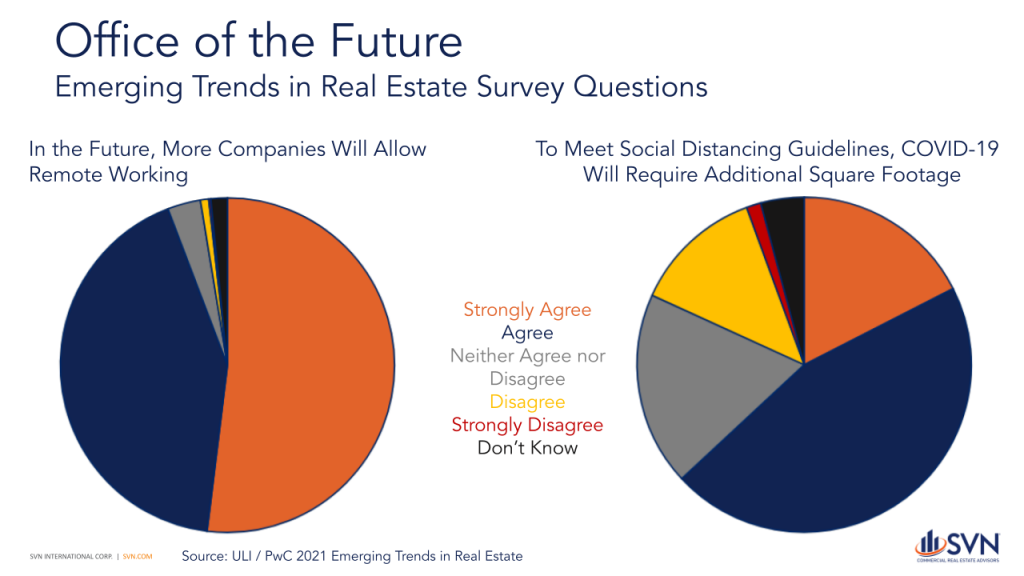
The likelihood that total office space demand will have a smaller footprint in the post-pandemic world is a consideration that we cannot afford to take lightly. A Fitch research report released just last week estimates that an additional 1.5 work-from-home days per worker would lead to a 15% reduction in property-level net cash flow— a development that would meaningfully recalibrate our understanding of risk and value. Given the long-dated lease structure common throughout the sector, it will take a few years for emerging preferences to filter through fully. Moody’s Analytics REIS forecasts that vacancy rates are likely to rise to near-record levels through 2023 before beginning a gradual recovery in 2024.
Of course, not all metro-level office markets will move as one. Some of the migratory demand that is leaving large cities and contributing to localized weakness ahead will also lead to strength in other markets, particularly in major Metro adjacent suburbs. According to Real Capital Analytics, Central Business District-located Office properties posted a 0.2% decline in value for the year. On the other hand, suburban located office assets saw valuations continuing to grow at a healthy 6.6%.
Industrial
The industrial sector remained the undisputed top performer of commercial real estate through an otherwise challenging 2020. Secular tailwinds, such as e-commerce adoption, grew from a healthy gust to a sustained hurricane force. Over the past decade, online retail sales have increased by an average of 15.2% annually. Brick and mortar retail sales over the same period have only grown by an average of 3.4% per year. The share of total Retail sales satisfied by online orders has steadily risen, entering 2020 At 11.3%. In the second quarter, as nonessential retailers across the country closed their doors, this share skyrocketed above 16%. While the share has reverted down to 14%, the pandemic has permanently transitioned some in-person retailing onto online platforms. Online grocery delivery services, a concept that had faced greater consumer resistance than other E-platforms before 2020, stood uniquely positioned to benefit from the demands of a lockdown economy. According to grocery e-commerce specialist Mercatus and research firm Incisiv Projects, online grocers accounted for 3.4% of all US grocer sales in 2019, before swelling to 10.2% in 2020.4 Further, the same study estimates that online groceries will satisfy 21.5% of domestic demand by 2025. Surging demand for E-grocers also means an increased demand for distribution and fulfillment facilities in close proximity to consumers. In the most recent Emerging Trends in Real Estate report, fulfillment facilities ranked as the subsector with the best prospects for future investment and development opportunities.
Another source of new industrial demand can be traced to the supply chain disruptions experienced this last year. The pandemic exposed critical sensitivities, and e-commerce retailers are looking to better safeguard their ability to match inventory supply with order demand. Doing so has meant a transition away from “just in time” distribution models in favor of “just in case” models instead. The latter requires excess warehousing space to stock contingent inventory.
Retail
There was no shortage of pessimism surrounding the retail sector heading into 2020, even before there was a pandemic to contend with. Pre-pandemic, Retail was in the midst of what was widely expected to be a 10-year shakeout and a painful rightsizing process. As noted in the 2021 ULI / PwC Emerging Trends Report, the US retail sector had three major headwinds going into last year: the US has more retail square footage per capita than any other country in the world, an increasing share of core-retail activity has transitioned online, and domestic consumers have experienced a long-term stagnation of wages. Concepts that were on the path towards obsolescence, with hopes of maybe squeezing out a few more years of economic solvency, are those that have struggled the most during COVID— none more so than department store retailers.
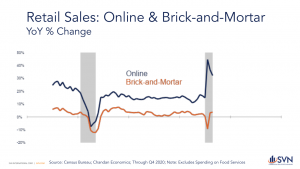
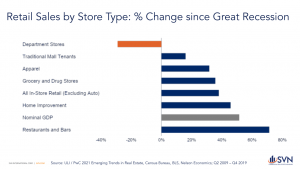
While the outgoing companies will argue otherwise, a case can be made that 2020’s pain will help the retail sector pave a quicker path back to recovery. The sector has gone from Darwinism to ‘Darwinism on steroids.’ Though, before we can imagine a radical future where physical retail demand sits just a bit higher than supply, the existing glut of obsolescent space needs to find adaptive reuse. After all, not every struggling mall will be turned into an Amazon distribution center. Lifestyle centers, where fitness centers, housing units, and mixed Retail are blended together, are one of the leading concepts to aid in re-positioning and re-absorption. According to Real Capital Analytics, Lifestyle Centers have an average price per square foot that is almost three times higher than average assessed for Mall assets, reflecting some of the value that can be recaptured through re-positioning.
As Retail continues to match physical footprints with the forward-looking consumer behavior, the short-term reversion back to normalcy will at least provide some much-needed relief. Cabin-fever-consumers armed with unspent stimulus checks should give Retailers a potent shot in the arm, even if the upside effects are only temporary.
Outlook
Whether it be the public health front, the economy, commercial real estate, our lives in general, or how all the above are inexorably linked, 2021 has all the makings of a year defined by recovery. The Federal government’s push to have vaccine availability for every US adult by May 1st means that herd immunity is not too far behind.
Between the safe resumption of our pre-pandemic lives, the commitment by the Federal Reserve to maintain low interest rates even as inflation pressures rise, and the unprecedented level of stimulus in the hands of consumers, a perfect storm of economic momentum is brewing just offshore. If anything, there is increasing concern that the economy has the potential to overheat in the year ahead as too much fuel enters the fire all at once. According to the February and March iterations of the Wall Street Journal’s Economic Forecasting Survey, a majority of leading economists believe that this year will have more upside risk than downside risk, and more than 80% think that the newly passed stimulus will generate inflation higher than the Fed’s 2% target.
In many ways, we as an industry remain in wait-and-see mode, with questions over a return to the office timing and rightsizing are still swirling overhead. Although, overly conservative and reactive strategies rarely make winning formulas in Real Estate. Now is the time for landlords to engage tenants and companies to engage employees about emerging preferences, then execute on a strategy. If 2020 has taught us nothing else, it’s that the pace of change can accelerate quickly, and falling behind the curve of innovation is a costly and often un-correctable mistake.
Endnotes
1. https://mf.freddiemac.com/docs/January_forbearance_report.pdf
2. https://www.cbpp.org/research/housing/housing-assistance-in-american-rescue-plan-act-will-prevent-millions-of-evictions
3. https://www.pwc.com/us/en/library/covid-19/us-remote-work-survey.html
4. https://www.supermarketnews.com/online-retail/online-grocery-more-double-market-share-2025

 Tampa has recovered significantly after experiencing deep impacts from the recession and is now growing jobs at an annualized pace of 3.6% with an unemployment rate of 4.8% as of January ‘16, according to the Bureau of Labor Statistics. Job growth also helped sustain population growth of 6.8% from 2010 to 2014, according to the Census Bureau. This growth has caused the multifamily sector in Tampa to expand with growing rents, falling occupancies, and lots of new supply. 2016 should bring approximately 5% rent growth with stable occupancy levels. The city is approximately 50% rental housing based and should demand more units as economic expansion continues. Top sectors for employment growth include Construction, Professional and Business Services, Leisure and Hospitality, and Financial Activities which have annualized growth rates of 7.1%, 7.1%, 6.6%, 3.4%, respectively.
Tampa has recovered significantly after experiencing deep impacts from the recession and is now growing jobs at an annualized pace of 3.6% with an unemployment rate of 4.8% as of January ‘16, according to the Bureau of Labor Statistics. Job growth also helped sustain population growth of 6.8% from 2010 to 2014, according to the Census Bureau. This growth has caused the multifamily sector in Tampa to expand with growing rents, falling occupancies, and lots of new supply. 2016 should bring approximately 5% rent growth with stable occupancy levels. The city is approximately 50% rental housing based and should demand more units as economic expansion continues. Top sectors for employment growth include Construction, Professional and Business Services, Leisure and Hospitality, and Financial Activities which have annualized growth rates of 7.1%, 7.1%, 6.6%, 3.4%, respectively. Seattle is one of the fastest growing cities on the West Coast, with a population that grew 9.8% from 2010 to 2014, according the Census Bureau. Job growth continues at an annualized pace of 3.0% while unemployment has been stable with the latest reading in January ‘16 of 5.6%, according to the Bureau of Labor Statistics. Seattle is an expensive city to live in and as such approximately 54% of the housing units are rentals, according to the Census Bureau. The need for ample housing is real and multifamily assets should perform well for 2016 and beyond. Rents are expected grow over 5% as new supply hits record highs to fill new demand. The best sectors for job creation include Information, Leisure and Hospitality, Trade, Transportation, and Utilities, and Financial Activities, which are growing at 8.1%, 5.0%, 4.2%, and 4.1% annualized rates, respectively.
Seattle is one of the fastest growing cities on the West Coast, with a population that grew 9.8% from 2010 to 2014, according the Census Bureau. Job growth continues at an annualized pace of 3.0% while unemployment has been stable with the latest reading in January ‘16 of 5.6%, according to the Bureau of Labor Statistics. Seattle is an expensive city to live in and as such approximately 54% of the housing units are rentals, according to the Census Bureau. The need for ample housing is real and multifamily assets should perform well for 2016 and beyond. Rents are expected grow over 5% as new supply hits record highs to fill new demand. The best sectors for job creation include Information, Leisure and Hospitality, Trade, Transportation, and Utilities, and Financial Activities, which are growing at 8.1%, 5.0%, 4.2%, and 4.1% annualized rates, respectively.
 San Jose is one of the hottest cities in the Bay Area and thus has experienced very strong employment growth since 2011 which has brought the unemployment rate down to 3.9% as of January ‘16 while jobs are still being created at the robust pace of 3.8% annualized according to the Bureau of Labor Statistics. Population growth is also significant at 6.6% from 2010 to 2014 as people find this market relatively more affordable. The San Jose housing stock is traditionally owner oriented with only 43% used for rentals. Given the rate of regional growth, local multifamily assets are very well positioned to pick up demand from surrounding areas a well as localized growth. Rent growth is expected to exceed 5% with relatively low new supply in 2016. Top sectors in job creation include Construction, Information, and Professional and Business Services with annualized growth rates of 10.3%, 8.4%, and 6.8%, respectively.
San Jose is one of the hottest cities in the Bay Area and thus has experienced very strong employment growth since 2011 which has brought the unemployment rate down to 3.9% as of January ‘16 while jobs are still being created at the robust pace of 3.8% annualized according to the Bureau of Labor Statistics. Population growth is also significant at 6.6% from 2010 to 2014 as people find this market relatively more affordable. The San Jose housing stock is traditionally owner oriented with only 43% used for rentals. Given the rate of regional growth, local multifamily assets are very well positioned to pick up demand from surrounding areas a well as localized growth. Rent growth is expected to exceed 5% with relatively low new supply in 2016. Top sectors in job creation include Construction, Information, and Professional and Business Services with annualized growth rates of 10.3%, 8.4%, and 6.8%, respectively. Reno is experiencing sustained gains in employment with a 4.4% annualized rate after being severely impacted by the past recession; unemployment has improved dramatically and now sits at a still relatively high 6.2% as of January ‘16, according to the Bureau of Labor Statistics. Population has grown robustly with a 4.9% increase from 2010 to 2014, according to the Census Bureau. As is common with tourist market economies, the percentage of city housing used for rental purposes is high at 53% meaning that job growth will quickly mean growth for the multifamily sector. The city’s economy is rapidly diversifying with the biggest gains coming from Construction, Professional and Business Services, Financial Activities, and Education and Health Services with annualized growth rates of 9.6%, 9.5%, 5.2%, and 5.0%, respectively.
Reno is experiencing sustained gains in employment with a 4.4% annualized rate after being severely impacted by the past recession; unemployment has improved dramatically and now sits at a still relatively high 6.2% as of January ‘16, according to the Bureau of Labor Statistics. Population has grown robustly with a 4.9% increase from 2010 to 2014, according to the Census Bureau. As is common with tourist market economies, the percentage of city housing used for rental purposes is high at 53% meaning that job growth will quickly mean growth for the multifamily sector. The city’s economy is rapidly diversifying with the biggest gains coming from Construction, Professional and Business Services, Financial Activities, and Education and Health Services with annualized growth rates of 9.6%, 9.5%, 5.2%, and 5.0%, respectively. Portland has experienced rapid employment growth in 2015, bringing the unemployment rate down to 4.7% as of January ‘16 while sustaining new job creation at a rate of 3.1%, according to the Bureau of Labor Statistics. Population in the city grew by 6.1% between 2010 and 2014 according to the Census Bureau who also reports that approximately 47% of the housing stock is used for rentals. Portland is a relatively high priced market for the nation but still affordable for a major West Coast metro with an excellent quality of life. Leading employment sectors include Information, Leisure and Hospitality, and Education and Health Services growing at 9.4%, 4.6%, and 4.5% respective annualized rates. These dynamics should lead to strong performance of the multifamily sector in 2016 and beyond with rents growing over 10% this year as new supply remains relatively moderate.
Portland has experienced rapid employment growth in 2015, bringing the unemployment rate down to 4.7% as of January ‘16 while sustaining new job creation at a rate of 3.1%, according to the Bureau of Labor Statistics. Population in the city grew by 6.1% between 2010 and 2014 according to the Census Bureau who also reports that approximately 47% of the housing stock is used for rentals. Portland is a relatively high priced market for the nation but still affordable for a major West Coast metro with an excellent quality of life. Leading employment sectors include Information, Leisure and Hospitality, and Education and Health Services growing at 9.4%, 4.6%, and 4.5% respective annualized rates. These dynamics should lead to strong performance of the multifamily sector in 2016 and beyond with rents growing over 10% this year as new supply remains relatively moderate. Phoenix experienced significant gains in overall employment in 2015 that moved the number of jobs significantly above pre-recession peaks as unemployment fell to 4.6% in January ‘16 with continued annualized employment gains of 3.6%. The population grew by 6.2% from 2010 to 2014, according to the Census Bureau, helping to fuel new demand for apartment units. The city utilizes approximately 46% of its housing units as rentals and has relative affordability with high quality of life making the market a prime one to grow in 2016 and beyond, with rents expected to grow over 5% this year. The leading employment sectors are Information, Construction, Financial Activities, Education and Health Services, and Professional and Business Services, growing at annualized rates of 7.6%, 6.3%, 5.3%, 5.2%, and 5.1%, respectively.
Phoenix experienced significant gains in overall employment in 2015 that moved the number of jobs significantly above pre-recession peaks as unemployment fell to 4.6% in January ‘16 with continued annualized employment gains of 3.6%. The population grew by 6.2% from 2010 to 2014, according to the Census Bureau, helping to fuel new demand for apartment units. The city utilizes approximately 46% of its housing units as rentals and has relative affordability with high quality of life making the market a prime one to grow in 2016 and beyond, with rents expected to grow over 5% this year. The leading employment sectors are Information, Construction, Financial Activities, Education and Health Services, and Professional and Business Services, growing at annualized rates of 7.6%, 6.3%, 5.3%, 5.2%, and 5.1%, respectively. Job growth in Philadelphia has brought the city back above pre-recession employment levels as unemployment stays steady at 4.8% as of January ‘16 with modest annualized employment growth of 2.1%, according to the Bureau of Labor Statistics. Population growth has been below the national average as the city only gained 2.2% from 2010 to 2014, according to the Census Bureau. Accordingly, demand for new apartment units is modest compared to other metros of similar size; yet the city does have a relatively high use of housing units as rentals at approximately 47%. Philadelphia does have an advantage in affordability, especially compared with other East Coast metros, and thus has growth potential with rents forecast to grow by over 3% in 2016. The city’s top sectors for job growth include Mining, Logging, and Construction as well as Professional and Business Services where are expanding at annualized rates of 8.2% and 3.7%, respectively.
Job growth in Philadelphia has brought the city back above pre-recession employment levels as unemployment stays steady at 4.8% as of January ‘16 with modest annualized employment growth of 2.1%, according to the Bureau of Labor Statistics. Population growth has been below the national average as the city only gained 2.2% from 2010 to 2014, according to the Census Bureau. Accordingly, demand for new apartment units is modest compared to other metros of similar size; yet the city does have a relatively high use of housing units as rentals at approximately 47%. Philadelphia does have an advantage in affordability, especially compared with other East Coast metros, and thus has growth potential with rents forecast to grow by over 3% in 2016. The city’s top sectors for job growth include Mining, Logging, and Construction as well as Professional and Business Services where are expanding at annualized rates of 8.2% and 3.7%, respectively. The multifamily market in Charlotte has experienced strong growth in demand as the city has gained 10.1% in population from 2010 to 2014, according to the Census Bureau. This has been fueled by significant job growth that has set new records substantially above pre-recession peaks, leading the present unemployment rate to sit at 5.3% as of January ‘16 with new job creation occurring at an annualized rate of 2.8%, according to the Bureau of Labor Statistics. Approximately 45% of the city’s housing stock is renter occupied. Thus, a good deal of the new population is likely to demand an apartment. Further, gross rents are below national averages, making Charlotte affordable and capable of seeing meaningful rent growth. New supply has grown approximately 4% in 2015 which will lower rent growth slightly in 2016, but still likely to be robust and above 4%. Many sectors are adding jobs at annualized rates above 4%, including Financial Activities, Professional and Business Services, and Leisure and Hospitality. However, this city does face a unique risk to continued growth from the new “bathroom” law, perceived very negatively by many; this could jeopardize new job growth and thus the market if firms choose to relocate or otherwise curtail operations in the state.
The multifamily market in Charlotte has experienced strong growth in demand as the city has gained 10.1% in population from 2010 to 2014, according to the Census Bureau. This has been fueled by significant job growth that has set new records substantially above pre-recession peaks, leading the present unemployment rate to sit at 5.3% as of January ‘16 with new job creation occurring at an annualized rate of 2.8%, according to the Bureau of Labor Statistics. Approximately 45% of the city’s housing stock is renter occupied. Thus, a good deal of the new population is likely to demand an apartment. Further, gross rents are below national averages, making Charlotte affordable and capable of seeing meaningful rent growth. New supply has grown approximately 4% in 2015 which will lower rent growth slightly in 2016, but still likely to be robust and above 4%. Many sectors are adding jobs at annualized rates above 4%, including Financial Activities, Professional and Business Services, and Leisure and Hospitality. However, this city does face a unique risk to continued growth from the new “bathroom” law, perceived very negatively by many; this could jeopardize new job growth and thus the market if firms choose to relocate or otherwise curtail operations in the state. The Denver multifamily market has experienced significant additions of new supply as its population has grown 10.6% from 2010 to 2014, according to the Census Bureau. Further, the employment market is outstanding with 3.0% unemployment as of January ‘16 and annualized job growth of 2.5%, according to the Bureau of Labor Statistics. Denver features a larger renter population with approximately 50% of its metro’s housing units used for rental purposes; still rental rates are relatively affordable for a metro of its size, giving it room to grow. Top sectors for employment growth include Leisure and Hospitality, Financial Activities, Manufacturing, and Professional and Business Services growing at annualized rates of 6.0%, 3.9%, 3.5%, and 3.2%, respectively. As such, rent growth could hit 7% in 2016.
The Denver multifamily market has experienced significant additions of new supply as its population has grown 10.6% from 2010 to 2014, according to the Census Bureau. Further, the employment market is outstanding with 3.0% unemployment as of January ‘16 and annualized job growth of 2.5%, according to the Bureau of Labor Statistics. Denver features a larger renter population with approximately 50% of its metro’s housing units used for rental purposes; still rental rates are relatively affordable for a metro of its size, giving it room to grow. Top sectors for employment growth include Leisure and Hospitality, Financial Activities, Manufacturing, and Professional and Business Services growing at annualized rates of 6.0%, 3.9%, 3.5%, and 3.2%, respectively. As such, rent growth could hit 7% in 2016. Boston’s economy has experienced significant job growth such that its unemployment rate is now 4.0% as of January ‘16 and new jobs are being created at a 1.4% annualized rate, according to the Bureau of Labor Statistics. Further, population has grown 6.2% from 2010 to 2014, according to the Census Bureau, and has thus significantly increased the demand for rental housing in the metropolitan region. Bostonians are highly predisposed to renting as over 65% of the housing units in the city are rentals according to Census data; thus prolonged population and job growth will place great pressure on rents which could grow over 6% in 2016 and keep occupancies above 97% while new supply is likely to remain less than 2% . The top sectors for job growth include Financial Activities and Education and Health Services which are growing at 3.1% and 2.9% annualized rates, respectively.
Boston’s economy has experienced significant job growth such that its unemployment rate is now 4.0% as of January ‘16 and new jobs are being created at a 1.4% annualized rate, according to the Bureau of Labor Statistics. Further, population has grown 6.2% from 2010 to 2014, according to the Census Bureau, and has thus significantly increased the demand for rental housing in the metropolitan region. Bostonians are highly predisposed to renting as over 65% of the housing units in the city are rentals according to Census data; thus prolonged population and job growth will place great pressure on rents which could grow over 6% in 2016 and keep occupancies above 97% while new supply is likely to remain less than 2% . The top sectors for job growth include Financial Activities and Education and Health Services which are growing at 3.1% and 2.9% annualized rates, respectively.





















